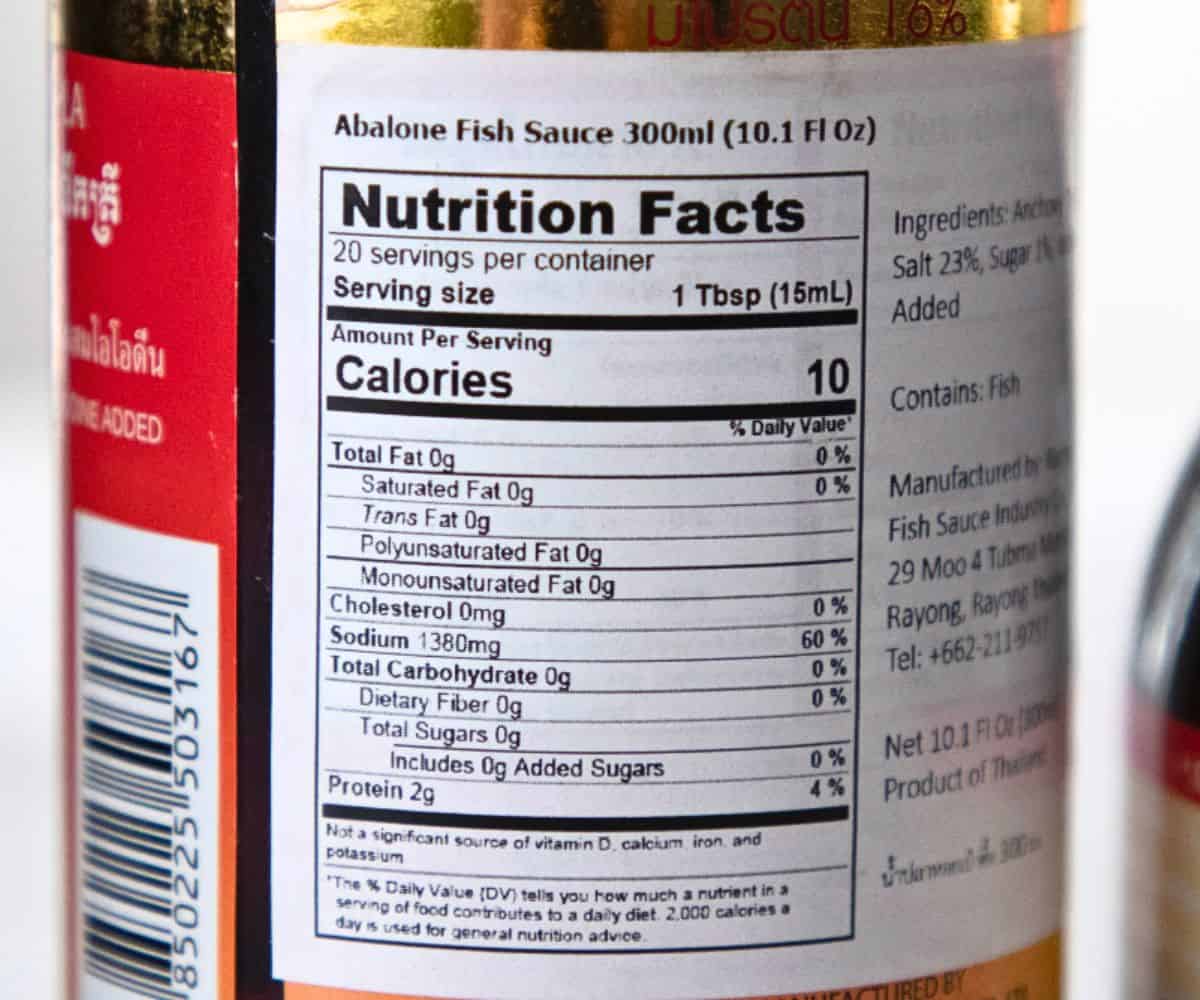Fish sauce is absolutely core to Thai cooking, so it is very important to use good quality fish sauce, and in this post and share with you all about how to choose good quality fish sauce.
But in recent years, more “premium” fish sauces have entered the market with higher and higher prices. So at what point is the extra money spent no longer worth the quality gain? THAT is what we’re here to find out.
So I tasted 4 different “premium fish sauces” at different price points, ranging from $9 to $30 US dollars per 300 mls. I tasted them straight up, in a raw application, and then taste in a cooked application to see if the difference is worth the price.
You can read this article, but for a more complete experience below is the video of my taste test so you can see my live reactions. Everything covered in this article is also discussed in the video!
Video: Thai Chef Reviews Premium Fish Sauce!
What exactly is “premium” or “first press” fish sauce?
It is important that we first establish what exactly IS premium, or more specifically “first press” fish sauce, and how is it different from regular fish sauce? And no, just because it says “premium” on the label, does no make it so.
To understand this you have to know how fish sauce is made. Fish sauce is made by putting anchovies and salt together and letting it ferment over time. As the fish breaks down, the liquid from the fish comes out, mixes with the salt and THAT is the very purest, first press, extra virgin fish sauce. Or what we call in Thai hua nampla, which literally means “the head of the fish sauce.”
You can see some great pictures of how fish sauce is made in my video above, which are images of Squid fish sauce factory, originally from this article (Thai language).
Once the first press fish sauce has been removed from the tank, you can add more water and salt to the same fish and get a second press and even third press out of it, which is obvious more diluted.
Regular, inexpensive fish sauce that we get at the store is a combination of first press with subsequent presses in whatever ratio the manufacturer decides, which is why there’s such a big range of quality out there. And the really low quality fish sauce will have so little first press in it that they also have to add artificial colour and flavours to make up for it.
Our Contenders
Red Boat 40N Fish Sauce
The OG, the pioneer in the premium fish sauce market and the one who started the new wave of premium fish sauce.
- Origin: Vietnam
- Ingredients: anchovies and salt
- Protein per 15 ml: 4 g
- Sodium per 15 ml: 1430 mg
- Price as of Dec 2023: Calculated based on 300ml which is the most common size among these bottles, is $8.99 USD. Actual price per 500 ml bottle is $14.99.
The Royal Squid Fish Sauce
Regular Squid has been my go-to fish sauce for years, it’s a household name in Thailand that’s been around for 80 years. Recently they entered the first press market with their first press “Royal” fish sauce.
- Origin: Thailand
- Ingredients: anchovies and salt
- Protein per 15 ml: 2 g
- Sodium per 15 ml: 1620 mg
- Price as of Dec 2023: $12.99/300 ml from an online shop but it is no longer available. In stores this will be cheaper but it is not available to me locally. I’ve heard some people report that they can get it at their local Asian markets. Do let me know in the comments if you can find it in your stores and how much it costs!
Abalone Fish Sauce
This name is not well known at all in the Western market, but it came up a lot when I was researching popular fish sauces amongst Thai people so I got interested and turns out you can buy it on amazon!
- Origin: Thailand
- Ingredients: anchovies, salt and sugar (we will discuss the sugar below)
- Protein per 15 ml: 2 g
- Sodium per 15 ml: 1380 mg
- Price as of Dec 2023: $11.49/300 ml on Amazon US, in stores this will probably be much cheaper.
Red Boat Phamily Reserve Maple Bourbon Fish Sauce
The most expensive fish sauce I’ve ever seen! This is Red Boat’s 50N fish sauce, their highest grade, that has been aged in maple bourbon barrels. I’m very interested in this to see if the maple bourbon flavours come through, and whether that’s a good thing.
- Origin: Vietnam
- Ingredients: anchovies and salt
- Protein per 15 ml: 5 g
- Sodium per 15 ml: 1430 mg
- Price as of Dec 2023: Calculated based on 300ml is $29.98 US. Actual price per 200ml bottle is $19.99 US
Protein Content in Fish Sauce – What does it mean?
Protein content in fish sauce basically tells us how much “fish juice” actually made it into the bottle. Higher protein, indicates higher fish content, and the more flavourful and umami it is supposed to be.
For our lineup, the maple bourbon is highest in protein, followed by Red Boat 40N Original, then the Thai ones.
Quickly, the N number you often see on fish sauce labels is also an indication of protein content. N stands for nitrogen, which is a unique component of protein, hence its use to indicate protein content. The higher the N number, the higher the protein. You won’t usually see the N number on Thai fish sauces though because it’s just not a thing Thai people look at. Most of the time this will be on Vietnamese fish sauces OR export version of Thai fish sauce such as blue label Megachef. (Domestic versions of Megachef, the brown label, does not have the N Number).
Added Sugar in Fish Sauce – Is it bad?

All “regular,” non-first press fish sauce has sugar added. Sugar is added to help balance the saltiness in fish sauce to make it a little smoother. In the same way that I add sugar to many of my dishes to balance the salt.
The amount of sugar added in fish sauce is so small that it doesn’t even register on the nutritional label – it will show as zero grams of sugar per 15 ml. And if you taste it, you will realize how little sugar there is!
So I personally don’t think there’s anything wrong with it, and in fact, if it helps the flavour, why not. And if I use no-sugar fish sauce, and the saltiness of the dish isn’t balanced, I’m going to have to add sugar to balance it in the dish anyway so it’s a moot point for me.
Most firs press fish sauces tend not to add sugar to keep it as pure as possible, with the exception of Abalone which adds 1% sugar, and again, it is so little that it registers as 0 on the nutritional label.
The Results #1 – Straight up Taste Test

Tasting the fish sauces straight up, my favourite one was Abalone. It has a smell that’s pleasant and not too strong, the least amount of sodium and added sugar make it go down very smoothly, and it has a rich, long lasting umami in the mouth.
The Royal Squid was a runner up as it was saltier and less smooth than abalone.
Classic 40N Red Boat has a very rich flavour, as indicated by the higher protein content, that really lingers for a long time. But it is a much “fishier” fish sauce than Abalone and Royal Squid, which I didn’t like as much, and I can see situations where this would be too strong.
The Maple Bourbon Red Boat had a very intense aroma of both fishiness and bourbon, though not so much maple. But it also had a fermented funk reminiscent of pla ra, padaek, or shrimp paste. I thought this was interesting and wonder if this is the case for every batch. Though it doesn’t have the highest sodium content, it felt the saltiest because of the strength in flavour. Too strong to be had straight up in this way, I think. It’s best to see my reaction in the video!
To keep things in perspective, I also tasted it against regular, non-premium Squid fish sauce. And indeed, compared to premium fish sauces, regular Squid felt very salty, jarring, with a much lighter body. So yay, you’re paying for something!
Squid fish sauce, by the way, is a decent fish sauce that’s a classic in Thailand. It is perfectly sufficient for everyday cooking. It is also what I use for my recipes when I develop them for my website and cookbooks because it is the saltiest one on the market. I do this on purpose so that when people follow my recipes, they won’t end up with a dish that’s too-salty just because they used a different brand of fish sauce.
The Results #2 – Condiment Taste Test

Now the test that matters: let’s put these to use. First I’m gonna use it in a raw form, by making a sauce called prik nam pla, aka the condiment that can improve all foods! It’s simply a mixture of fish sauce, lime juice, chilies, and garlic, and I’m going to to be drizzling this on fried egg over rice which is one of the most common uses for prik nam pla.
All the differences that I tasted in the straight-up test carried through, but because we have introduced other ingredients, the differences are now less obvious.
My favourite by far was Abalone. The addition of sugar really made a difference in flavour for this condiment. Royal Squid was my second choice, and I found Red Boat 40N a little too fishy for this use, so I preferred the previous two, though it was still delicious.
Maple Bourbon (MB) 50N fish sauce, however, is not something I would use for prik nam pla. Not that it was bad, it wasn’t, but because I had an expectation of what prik nam pla tastes like, the MB was too different that it turned it into something else. In addition, the bourbon aroma was gone when eaten with food, which was disappointing because it’s kind of the whole point of this fish sauce and really what you’re paying extra for.
When tasted against prik nam pla made with regular Squid fish sauce, I still prefer ones made with the 3 premium fish sauces (not the MB), but the difference is becoming very very slight.
The Surprising Results #3 – Cooked Dish Taste Test

The final test is to actually cook with these. I’m gonna make my favourite veg side dish: garlicky cabbage fish sauce stir fry because it uses only fish sauce as the seasoning, and has very few other ingredients. So it will have the highest likelihood of the differences being detectable. And of course we’re going to be serving this with rice.
In this test, I found very unexpected results! The differences between Red Boat 40N, Royal Squid and Abalone at this point is veeery very slight. I could taste the difference, but it was really splitting hairs at this point, and among these 3, Abalone was still my favourite.
However, when I tasted the MB 50N, it was the best one! The bourbon aroma was gone, and so was that fermented funk (it was in the air when we were cooking so that explains where that went), and what’s left is a really rich, full-bodied fish sauce that was super delicious. It oddly didn’t feel strong or fishy.
I wondered why Red Boat 40N didn’t taste somewhere in between MB 50N and Abalone/Squid, and instead the 3 of them tasted very close to each other. I think it might be the level of heat that each was exposed to. Seeing as I couldn’t exactly control the heat of the wok, it’s a variable that could affect the taste of the sauce. Perhaps the MB 50N was exposed to more heat, and therefore evaporated the funky aroma and fishiness, and concentrated the umami? I can only guess.
I tasted one made from regular Squid next to MB 50N, the best and the worst, for the final judgment. And even though the MB 50N does taste better, I was still very satisfied with the regular Squid! It’s still a delicious dish, in fact they all are, and if I wasn’t doing a side by side test, there’s no way I would be able to tell how they were different.
Conclusion: My Takeaway
My takeaway from this is that when you’re going to cook with fish sauce, and especially if you’re going to introduce a lot of ingredients and seasonings, a decent quality, regular fish sauce is totally fine. The difference at the end of the day is so small that you’ll be hard pressed to taste the extra cash you spent on a fancy bottle.
However, when using it in a relatively pure form, such as in a condiment, the difference can really shine through. And for me personally, I’ll be upgrading my prik nam pla to using Thai Abalone fish sauce!
This is a good time to remind you that these reviews are based on my personal preference, which may be different from yours. You could certainly conduct a similar taste test to find out what your favourite is! But I hope that this helps better inform your decision next time you’re needing to buy a next bottle of fish sauce!
Recipes for Your Premium Fish Sauce
Here are some recipes that use fish sauce as the main seasoning that you might want to use your premium fish sauce for:

